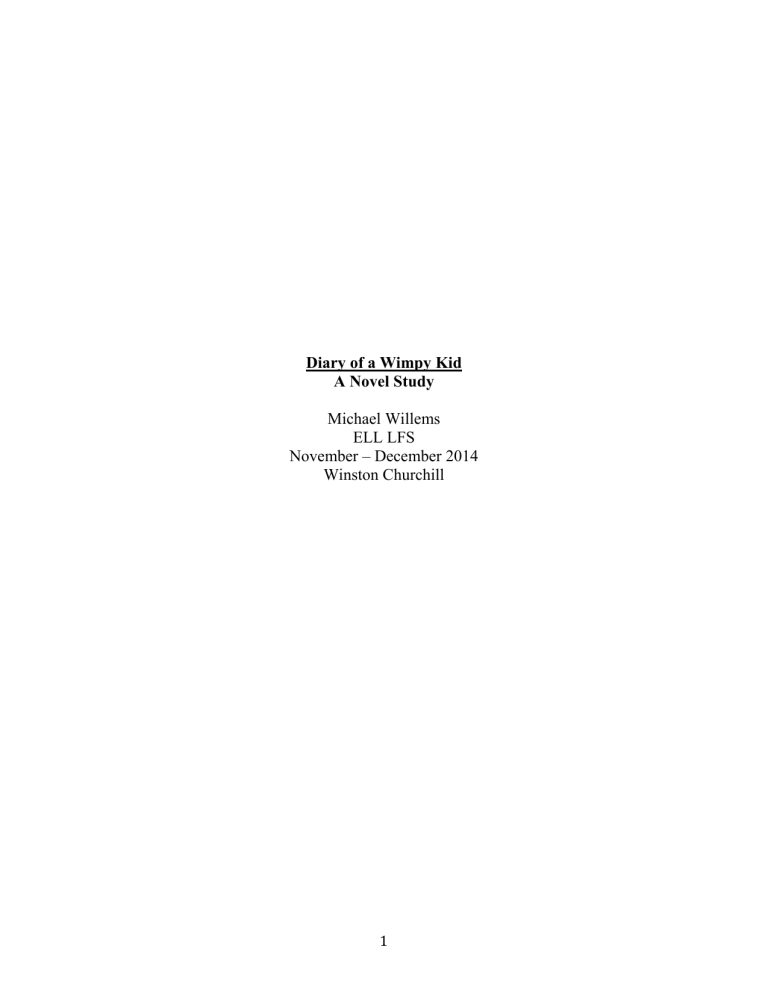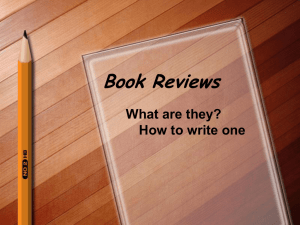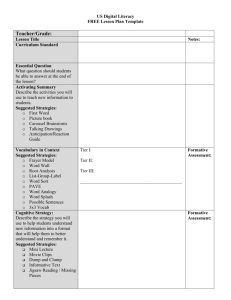Diary of a Wimpy Kid Novel Study Unit Plan

Diary of a Wimpy Kid
A Novel Study
Michael Willems
ELL LFS
November – December 2014
Winston Churchill
1
Table of Contents
Overview, Bibliography
Page 3
Essential Questions, Intended Learner Outcomes, Learning Activities
Page 4
Evaluation, Differentiated Instruction & Accommodations, Calendar
Page 5
Chapter Exam Exemplar
Character Sketch Exemplar
10
Other Worksheet Exemplars
Page 11
Page 8
Page
2
OVERVIEW
This unit is a novel study of Jeff Kinney’s Diary of a Wimpy Kid.
Reading: Reading is the most integral part of a novel study. Reading will take many forms throughout the unit—group, individual, choral, audiobook—to ensure that the students are grasping the concepts of the story.
Novel Terms: Throughout the unit we will go over important terms regarding comic books and a book study. Terms will include definitions, examples, and in some cases, larger projects based around the terms.
Vocabulary: As we progress through the book the students will pick out the words that they find difficult to understand. They will use the jigsaw technique by defining the words online and submitting them to the class website where everyone will be able to access them.
Website: There will be an active class website that the students can access that contains lesson reviews, access to audiobooks, their featured word lists, character lists, and chapter questions. (www.dwimp.weebly.com)
Take-Home Questions: For every chapter, students will receive 10 to 15 take home questions to ensure that the reading, and comprehension, has occurred.
BIBLIOGRAPHY
Elsasser, Danielle. “Diary of a Wimpy Kid Book Study.”
Teachers Pay
Teachers.
Dec. 2013. Web. 15 Oct. 2014. < http://www.teacherspayteachers.com/Product/Diary-of-a-Wimpy-Kid-Book-
Study-983901 >.
Gutierrez, Peter. "Diary of a Wimpy Kid: A Teaching Guide to the Series."
Wimpy Kid . Teachers College Press, Jan. 2013. Web. 15 Oct. 2014.
< http://www.wimpykid.com/wp-content/uploads/2014/04/WimpyKid-
SeriesTeachingGuide.pdf
>.
Kinney, Jeff. Diary of a Wimpy Kid: Greg Heffley's Journal . New York:
Amulet, 2007. Print.
Safford, Dani. “Diary of a Wimpy Kid Reading Comprehension Student
Workbook.”
Teachers Pay Teachers . Dec. 2012. Web. 15 Oct. 2014.
< http://www.teacherspayteachers.com/Product/Diary-of-a-Wimpy-Kid-Reading-
Comprehension-Student-Workbook-363535 >.
3
ESSENTIAL QUESTIONS
How do we read a novel? How do pictures in a novel help give us context?
What is the purpose of self-expression?
INTENDED LEARNER OUTCOMES
All of our students are aiming to achieve the Levels 1-2 Alberta ESL
Benchmarks. These benchmarks address four of the six Language Arts; listening, speaking, reading, and writing. Interactions with the book will improve their vocabulary, grammar, syntax, comprehension and fluency. The use of a book interspersed with pictures will increase their socio-linguistic awareness as we study the context that pictures bring to the story.
LEARNING ACTIVITIES
On top of the vocabulary words we learn every day, we will also feature comic book and novel terms:
.
-
Character - people in the story.
-
Slang – informal, not proper words.
-
Protagonist – the main, good character.
-
Antagonist – the main, bad character.
-
Plot – the events of the story
-
Summary – telling what has all happened in the story
-
Journaling – writing down one’s own stories
-
Context – the parts surrounding the event
-
Irony – the opposite of what you expect happens
-
Prediction – guessing what will happen
Students will participate in different activities encourage their own selfexpression, that analyze body language and inflection in storytelling, that dissect characters and their attributes, and that predict possible outcomes.
EVALUATION
Students will be taking home questions for each chapter to ensure reading and comprehension is taking place. Pop quizzes will occur throughout the novel to ensure that the students are grasping the concepts at an individual level. These will act as summative evaluations. Another form of summative assessment will be the small assignments, such as the character sheet and cover page, that will
4
accompany the chapters. There will be daily review of the events of the story and large group comprehension questions that will act as formative assessment.
DIFFERENTIATED INSTRUCTION & ACCOMODATIONS
Reading and understanding the story is a large focus of the ESL curriculum.
Students will have many differentiated opportunities to take in the story. They will:
have the book read to them by the teacher
read the books independently out loud
read the books independently silently
have access to audiobooks online
watch the accompanying movie following the reading
read in groups
Students will be asked in morning pages if they are requiring any specific assistance and their progress will be judged by the formative and summative evaluations.
CALENDAR
Lesson Date
#
1 Oct 29
Main Concept
Novel Overview
Activities Assessment
2
3
4
5
6
7
8
9
Nov 3
Nov 4
Nov 5
Nov 7
Nov 12
Nov 13
Nov 17
Nov 18
Chapter 1 Review
Characters
Vocabulary
Plot/Summary
Pictures
Protagonist and
Antagonist
Setting
Self-Expression
Comic book vs. novel
Introduce the website
Ch. 1 Done
Test on Ch. 1
Correct test responses
Character sketches
Website featured
Formative
Summative
Formative
Formative words
Go over defined words
Summarize Chapter 1
Group reading
Formative
Discuss ‘representing’
Summarizing pictures
Ch. 2 Done
Formative
Discuss novel terms
Independent reading
Ch. 3&4 Done
Discuss setting
Formative
Formative
Journaling assignment Formative
5
10
11 Nov 24 Narrative
12 Nov 25 Context
13
14
15
Nov 19
Nov 26
Nov 27
Nov 28
Group Reading
Context
Irony
Predictions
16 Dec 1
17 Dec 2
18 Dec 3
Self Expression
Group Reading
Character
19 Dec 4
20 Dec 5
Movie
Comparison
Final Exam
Group discussion
Journaling assignment
Ch. 5 Done
Narrative assignment
Acting out scenes
Discussing body language
Ch. 6 Done
Acting out scenes
Discussing inflection
Discuss irony
Comparisons
Ch. 7 Done
Predicting what will happen on picture prompts
Ch. 8 Done
Journaling assignment
Group discussion
Reading as groups
Ch. 9 & 10 Done
Character sketches and discussion
Watch the movie
Final Exam
Formative
Formative
Formative
Formative
Formative
Formative
Formative
Formative
Formative
Formative
Summative
6
Diary of a Wimpy Kid
Ch. 1 Exam
1.
Whose idea was it to write in the journal? a.
Greg’s dad b.
Greg c.
Greg’s mom d.
Greg’s teacher
2.
Why does he call it a ‘journal’ not a ‘diary’?
3.
Why did Ronnie McCoy get the attention of all the cute girls in 5 th grade? a.
He was cute b.
He had cooties c.
He had a girlfriend d.
He was a fast runner
4.
In middle school, what does Greg think are things that make it easier to get the girls’ attention,? a.
Lots of money b.
Nice clothes c.
A cute butt d.
All of the answers above are right
5.
What do you have to do to stop yourself from the Cheese Touch?
6.
What trick did Rodrick pull on Greg during the summer?
7.
What does it mean to have a ‘screw loose’?
8.
Which book was for the smarter group, ‘Einstein As a Child’ or ‘Bink Says
Boo’?
7
9.
What name does Greg’s little brother Manny call Greg?
10.
Greg is good at video games. What would his father like him to do instead of play video games? a.
His homework b.
Eat his dinner c.
Read a book d.
Play sports
11.
Greg’s mom thinks Rodrick’s rock-n-roll band is a good idea. Is this true or false?
12.
Why was Greg grounded from playing video games for two weeks?
13.
What reason did Vice Principal Roy have for taking Greg’s posters down? a.
They were ugly b.
They were too big c.
They were not true d.
They were too funny
14.
What is Greg’s friend’s name?
8
Character
Name
Character
Name
Diary of a Wimpy Kid Characters
Picture Adjectives
Picture Adjectives
Character
Name
Picture Adjectives
Pick a picture from this chapter that best represents (is a symbol for) the chapter.
ससस ससससस सससससस सससससस सससससससससससस
यस
सससससससस सससस
एक
सससससस ससससससस
9
Draw the picture here:
Why did you pick this picture? Why does it represent the chapter?
10





